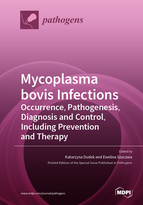Mycoplasma bovis Infections: Occurrence, Pathogenesis, Diagnosis and Control, Including Prevention and Therapy
A special issue of Pathogens (ISSN 2076-0817).
Deadline for manuscript submissions: closed (30 June 2020) | Viewed by 35535
Special Issue Editors
Interests: ruminant mycoplasmas, immunology, vaccines
Special Issues, Collections and Topics in MDPI journals
Interests: Mycoplasma infections, immunology, vaccines, therapy, antimicrobial resistance
Special Issue Information
Dear Colleagues,
Mycoplasma bovis is known as an etiological agent for many disorders in cattle, among which the most important are bronchopneumonia, mastitis, and arthritis. M. bovis infections are a serious economic and cattle health and welfare problem worldwide. M. bovis affects different age groups of cattle, and it can persist in a herd for very long period of time. Moreover, in vitro studies on M. bovis field isolates show increasing trends in antimicrobial resistance. Currently, no commercial vaccines against M. bovis are available in Europe, and only some autogenous vaccines are used in parts of Europe and the United States. The Special Issue will cover all aspects of M. bovis infections, such as pathogenesis, diagnosis and control, including therapy and prevention. The Special Issue will consist of reviews, as well as original manuscripts.
Dr. Katarzyna Dudek
Dr. Ewelina Szacawa
Guest Editors
Manuscript Submission Information
Manuscripts should be submitted online at www.mdpi.com by registering and logging in to this website. Once you are registered, click here to go to the submission form. Manuscripts can be submitted until the deadline. All submissions that pass pre-check are peer-reviewed. Accepted papers will be published continuously in the journal (as soon as accepted) and will be listed together on the special issue website. Research articles, review articles as well as short communications are invited. For planned papers, a title and short abstract (about 100 words) can be sent to the Editorial Office for announcement on this website.
Submitted manuscripts should not have been published previously, nor be under consideration for publication elsewhere (except conference proceedings papers). All manuscripts are thoroughly refereed through a single-blind peer-review process. A guide for authors and other relevant information for submission of manuscripts is available on the Instructions for Authors page. Pathogens is an international peer-reviewed open access monthly journal published by MDPI.
Please visit the Instructions for Authors page before submitting a manuscript. The Article Processing Charge (APC) for publication in this open access journal is 2700 CHF (Swiss Francs). Submitted papers should be well formatted and use good English. Authors may use MDPI's English editing service prior to publication or during author revisions.
Keywords
- Mycoplasma bovis
- cattle
- pneumonia
- mastitis
- arthritis
- bovine respiratory disease
- pathogenesis
- diagnosis
- control
- immune response
- antimicrobial resistance
- prevention
- therapy
- vaccine








